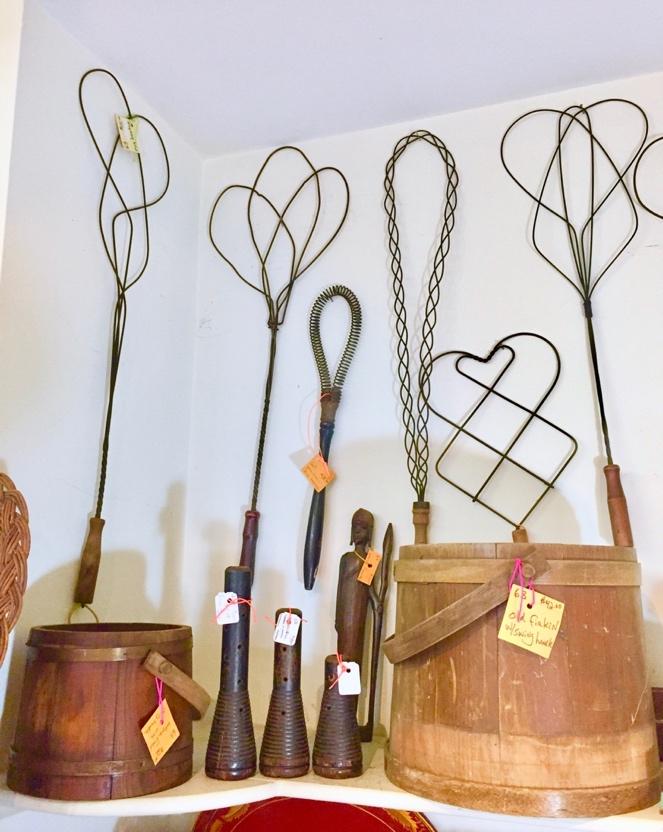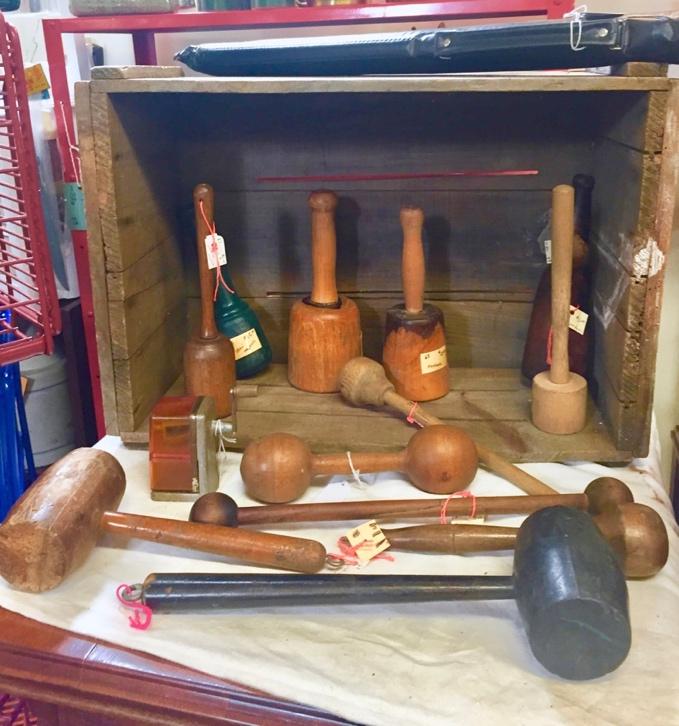American primitives are harder and harder to come by these days. The handmade furniture and everyday objects from 1700-1900, a time before manufacturing, were made with purpose and care and meant to last for years.
These kinds of items have been popular among collectors for their history, craftsmanship, and beautifully aged looked. Younger generations of collectors know less about this era, so here is a short run down on a few pieces in the shop to spur some interest!
These kinds of items have been popular among collectors for their history, craftsmanship, and beautifully aged looked. Younger generations of collectors know less about this era, so here is a short run down on a few pieces in the shop to spur some interest!
Below is a collection of primitive objects found on the top floor of the shop.
- The bent, curved and braided wire pieces with hand carved wooden handles are rug beaters, also known as a mattenklopper, carpet whip or dustbeater. These were popular items until the invention of the mechanical carpet sweepers. Often made of bent cane or wire, twisted into decorative and functional shapes, these were often hung on the walls of an early American home for use and decoration.
- The wooden buckets are called, Firkins, which were designed to hold liquids or for use in churning butter. In the 16th century they were so commonly used, a Firkin was used as a term of measurement, mainly used for ale, beer and butter. The use of the Firkin evolved with time, being used in the 17th century as a compost bucket for food waste and later used to reference a lunch pail. Find out more about the Firkin here.
- The three spools in the middle of the two buckets are from textile looms. Wooden, hand hewed spools with various hold for thread to run through when attached to the production loom.
Here is a nice collection of wood carving tools, mashers, mallets, muddlers and pestles. These were likely made by a farmer or craftsman for personal use or trade. Most primitive objects that were used in the house were made by the homeowner. These items would be passed down generationally until they were no longer usable. Most primitive American pieces have been well worn, creating a beautiful aged patina.

- The back row of tools are a mix of food mashers, pestles and wood carver’s mallets. The wooden masher is one the oldest kitchen tools that we still use today. The first masher can be traced back to ancient Egypt. Very similar to the wooden masher is the wood carver’s mallet was often used to tamp a chisel while carving wood or stone.
- The pestles, have a rounded end and a formed handled made for gripping. These tools date back to early civilization, and are still found in kitchens and workshops today. They were used with a bowl or a shallow container to grind down materials into fine pastes or powders.
- The large mallets in the foreground were used for a variety of tasks, used much like a hammer but made to give a less powerful blow. The mallet is a very common tool that has also been around for centuries and is still used today.
- The two pieces in the middle that resemble barbells, have been hard to identify. If anyone knows what these items were used for please let us know!
These timeless tools have proven to be mainstays in modern everyday activity; so, next time you’re vacuuming or making mashed potatoes try to imagine your ancestors using these tools, and think about how easy you’ve got it.
